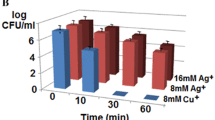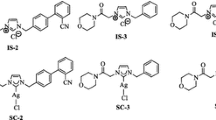Abstract
The bacteriostatic potency of the cerium-humic acid complex was evaluated by experimental measurement of this complex interaction with E. coli, Bacillus pyocyaneus, Staphylococcus aureus, Leuconostoc and Streptococcus faecalis, and by comparison bacteriostatic effects with the cerium-citrate complex. The experimental results indicated that the cerium-humic acid complex strongly inhibited growth of all five bacterial strains, and its diameter of bacteriostatic circles were more than 30 mm. The minimal bacteria-inhibiting concentration were 1×10−3, 2×10−3 and 1×10−2 mol/L for E. coli and Bacillus pyocyaneus, Staphylococcus aureus, and Leuconostoc and Streptococcus faecalis individually, and the measured minimal bactericidal concentrations were 2×10−3 and 1×10−2 mol/L for Bacillus pyocyaneus, E. coli, and Leuconostoc. To kill Staphylococcus aureus and Streptococcus faecalis, the concentration had to be more than 1×10−2 mol/L. On the contrary, we found that cerium-citrate complex did not inhibit the growth of the above five bacteria, but stimulated bacterial growth. The completely different bacteriostatic results of two cerium complexes may hint that the association and chemical properties of the two complexes were different.
Similar content being viewed by others
References
A. Muroma, Studies on the bactericidal action of salts of certain rare earth element, Ann. Med. Exp. Biol. Fenn. 36, 1–54 (1958).
D. E. Talburt and G. T. Johnson, Some effects of rare earth elements and yttrium on microbial growth, Mycologia 59, 493–503 (1967).
E. Domotor, Treatment of first and second degree burns with Phlogosam ointment, Ther. Hung. 17, 40–43 (1969).
L. Monafo, The use of topical certain nitrate-silver sulfadiazine in major burn injuries, Pan. Minerva Med. 25, 151–156 (1983).
L. W. Deng and Z. S. Zhang, Rare earth pharmaceuticals and pharmaceutical properties (in Chinese), Rare Earth 3, 39–40 (1987).
J. Z. Ni, Bio-inorganic Chemistry of the Lanthanides (in Chinese), Science Press, Beijing, pp. 42–50 (1995).
C. H. Evans, Biochemistry of the Lanthanides, Plenum, New York, pp. 20–21 (1990).
Author information
Authors and Affiliations
Rights and permissions
About this article
Cite this article
Zhang, H., Feng, J., Zhu, W. et al. Bacteriostatic effects of cerium-humic acid complex. Biol Trace Elem Res 73, 29–36 (2000). https://doi.org/10.1385/BTER:73:1:29
Received:
Accepted:
Issue Date:
DOI: https://doi.org/10.1385/BTER:73:1:29




